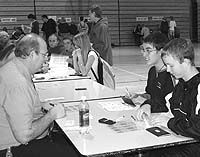| Principal Garth Johnson helps Adam Singleton and Cameron Hansen make insurance decisions. |
Ninth grade students at San Rafael Junior High School in Ferron recently had a close brush with life. On Nov. 23, the ninth graders were given a booklet that described their new life.
Prior to that date, Christine Hunt , school counselor, had taken the students grade point average and submitted it to a company affiliated with Reality Town. Reality Town is a place where students facing adulthood go to get a first hand look at what life after school can be. With the grade point average, Reality Town prepares a lifestyle booklet for the student with the projection of a life scenario based on the student’s performance in school to that point. Students are given the scenario in the handbook. A profession is listed, along with a marital status and family size. The estimated income of one, or both spouses is listed along with the amount of taxes and automatic loan payments, such as college loans that is to be deducted from the income.
At this point, the student is instructed to go to the bank and open a checking and/or savings accounts before visiting any other businesses. Around the perimeter of the gymnasium are 20 individual booths which represent different facets of everyday life for the average adult. They are: bank, child care, clothing, communications, dental, donations, entertainment, grocery, home improvement, housing, insurance (car), insurance (health), Just My Luck, medical, personal care, property taxes, transportation, utilities, and two optional places named financial counseling and supplemental income.
Following the visit to the bank, the student is then free to visit the remaining booths in any order they wish, but before the day is over, the student must visit all of the booths. Decisions must be made at each booth concerning the amount to be spent on each necessary item. The goal for the student is to have money left over after visiting each booth.
The financial counseling booth, which is optional, is set up to instruct and advise the student if problems arise. The supplemental income booth, also optional, is to help the student get a second job if their income is not enough to cover their expenses.
Students were faced with the challenge of making the income fit their preferred lifestyle. For example, at the transportation booth, the student is given the option of the kind of car they wish to purchase. The monthly cost of the vehicle the student wants is figured, including gas and maintenance costs. The decision must then be made about whether the type of vehicle that is wanted is one that will fit into the amount of income which is available. When it comes to car insurance costs, a card is drawn which will inform the student about the number of tickets he has and how that affects the cost of insurance.
As with the transportation booth, each booth had its own unexpected decisions to be made by the student. Then, as an added surprise, the Just My Luck booth is where the student draws a card. Some of the cards were good things, such as an unexpected inheritance. But, others were not so good as they were another obstacle, such as the furnace in the home has broken and needs repair immediately.
Following the visits to each booth, the students then analyzed their performance. They learned how purchasing an item on a credit card can end up costing a lot more than it is worth. They also learned how interest works to add to the balance and how to calculate the length of time required to pay off an item.
Many also learned that good grades in junior high school, then in high school can help achieve a better education following high school. With that higher level of education, the student is better able to attain the things that are necessary in life.

